The global pre-workout supplements market is valued at USD 21.7 billion in 2025 and is expected to reach USD 44.7 billion by 2035, reflecting a CAGR of 7.5%.
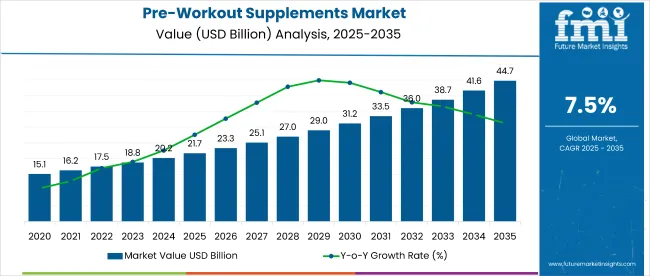
| Metric | Value |
|---|---|
| Estimated Size (2025E) | USD 21.7 billion |
| Projected Value (2035F) | USD 44.7 billion |
| CAGR (2025 to 2035) | 7.5% |
Market expansion is driven by increased health awareness, demand for performance-enhancing nutrition, and the popularity of high-intensity fitness regimes. Rising participation in recreational and professional sports, along with growing gym memberships globally, is further fueling demand for specialized pre-workout formulations.
The market holds approximately 21% of the global sports nutrition market, reflecting its strong presence among fitness-focused consumers. Within the broader dietary supplements market, it contributes around 8%, driven by the growing demand for energy-boosting formulations.
The segment captures nearly 6% of the functional food & beverages market, owing to innovations in ready-to-drink formats. In the expansive health & wellness market, it holds close to 4%, while within the fitness and performance nutrition market, its share rises to 28%, making it one of the fastest-growing subcategories in the sector.
Government regulations impacting the market focus on support for fitness initiatives and health awareness campaigns, particularly in countries like India and the UK. Key companies are focusing on proprietary ingredient formulations and expanding their digital retail presence to strengthen market positioning.
In addition, the rising popularity of personalized nutrition and subscription-based supplement models is expected to create new growth opportunities for industry players. The integration of AI-driven fitness tracking and supplement recommendation tools is also anticipated to enhance consumer engagement and product efficacy.
Europe is expected to retain the largest share of the global pre-workout supplements market in 2025, led by the UK with a 7.8% CAGR. Meanwhile, Germany and France closely follow this rapid growth with respective CAGRs of 7.2% and 7.0% through 2035.
Powdered supplements are set to remain the preferred product form with a 56% share, driven by customizable nutrition and convenience. Offline channels will continue leading the distribution segment with a 61% market share in 2025.
The pre-workout supplements market is segmented into form, sales channel, and region. By segment, the market includes powder, ready to drink, and capsule/tablets.
Based on sales channel, the market categorized into offline sales channel (supermarkets/hypermarkets, departmental stores, convenience stores, other sales channel (including specialty nutrition stores and fitness clubs) and online sales channel (company website and e-commerce platform).
Regionally, the market is divided classified into North America, Latin America, Western Europe, Eastern Europe, Balkans & Baltic, Russia & Belarus, Central Asia, East Asia, South Asia & Pacific, Middle East & Africa.
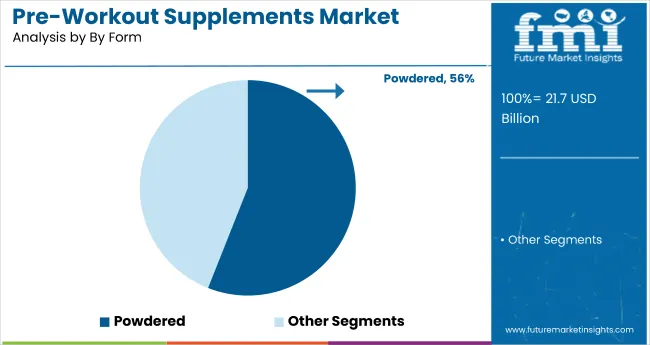
Powdered pre-workout supplements are expected to dominate the type segment, accounting for a 56% of the global market share in 2025. These supplements are widely preferred due to their customizability, shelf stability, and cost-effectiveness. Fitness enthusiasts and athletes favor powders as they can tailor dosage and mix with other ingredients for the desired taste or nutrition. Their availability in multiple flavors and pack sizes supports broader consumer appeal, especially among regular gym-goers.
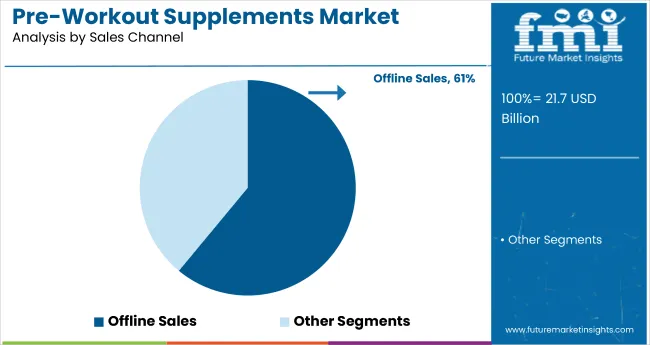
Offline sales channels are projected to lead the sales channel segment, accounting for 61% of global market share in 2025. Supermarkets, departmental stores, and fitness specialty outlets continue to dominate due to consumer preference for in-person consultation and physical verification of products. Offline availability also supports impulse purchases and immediate fulfillment. Despite online growth, brick-and-mortar stores remain essential for brand visibility and trust-building.
The global pre-workout supplements market has been experiencing steady growth, driven by increasing health consciousness, the rise of high-intensity training programs, and growing interest in sports nutrition across all age groups. Consumers are actively seeking performance-enhancing formulations that boost energy, endurance, and focus during workouts, leading to strong demand for pre-workout products with functional ingredients like caffeine, beta-alanine, and creatine.
Recent Trends in the Pre-Workout Supplements Market
Key Challenges in the Pre-Workout Supplements Market
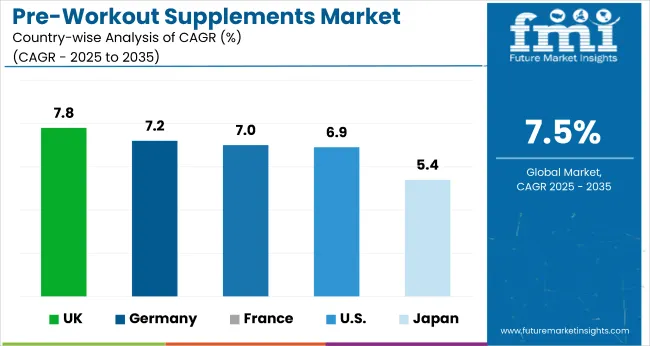
The UK leads the pre-workout supplements market driven by strong consumer demand for formulations that enhance stamina, muscle pumps, and mental focus.
In Germany and France, growth rates of 7.2% and 7.0%, respectively, are being recorded due to rising demand for clean-label and functional nutrition. While, the USA market is projected to grow at 6.9% CAGR and Japan, at a CAGR of 5.4%.
The report covers an in-depth analysis of 40+ countries; with the five top-performing OECD nations highlighted below.
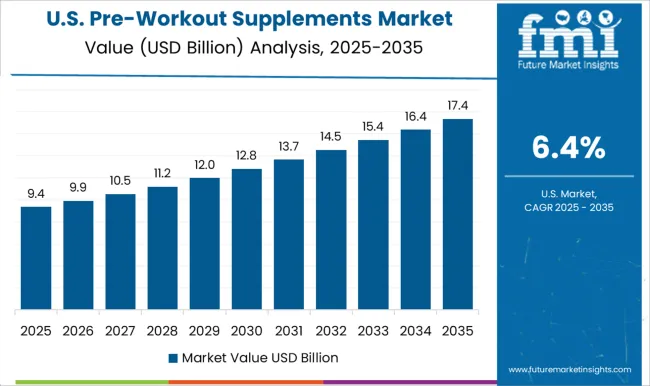
The pre-workout supplements revenue in the USA is growing at a CAGR of 6.9% from 2025 to 2035. The country leads global demand due to a high concentration of fitness enthusiasts, strong penetration of gym chains, and a well-established supplement industry.
American consumers prioritize performance and recovery, driving innovation among leading manufacturers. As regulations favor ingredient transparency, new launches targeting vegan and stimulant-free needs are gaining traction, solidifying the country’s dominant position in this sector.
The sales of pre-workout supplements in the UK are expanding at a CAGR of 7.8% during the forecast period. growth is driven by rising disposable income and heightened health consciousness, which have resulted in increased gym memberships and greater use of fitness nutrition products.
A surge in fitness influencer marketing and growing interest in body transformation programs are also driving product visibility and usage. The UK’s regulatory framework encourages product labeling transparency, enabling consumer trust in branded and private-label offerings.
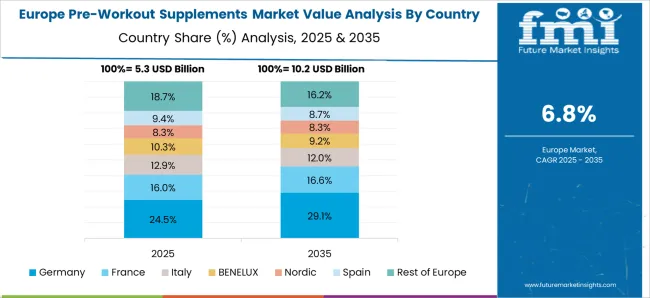
The demand for pre-workout supplements in Germany is projected to grow at a CAGR of 7.2% from 2025 to 2035. Growth is driven by strong demand for scientifically backed and premium-quality formulations, particularly among athletes and sports professionals. German consumers place high importance on ingredient safety and efficacy. As fitness culture expands across demographics, powdered and capsule forms remain highly preferred.
The pre-workout supplements market in France is projected to grow at a CAGR of 7.0% from 2025 to 2035. French consumers are increasingly engaging in wellness routines, fitness classes, and at-home workouts, which has accelerated supplement consumption. There is a growing preference for stimulant-free products, aligning with the national shift toward holistic health. The urban youth segment is particularly receptive to powdered and ready-to-drink formats with natural flavors and organic certification.
The pre-workout supplements market in Japan is projected to grow at a CAGR of 5.4% from 2025 to 2035. The country’s aging population is driving interest in functional nutrition for energy, endurance, and muscle maintenance. Japanese consumers value minimalistic, high-purity ingredients and are cautious about stimulants. The rise of fitness centers and wellness apps is creating awareness among younger generations.
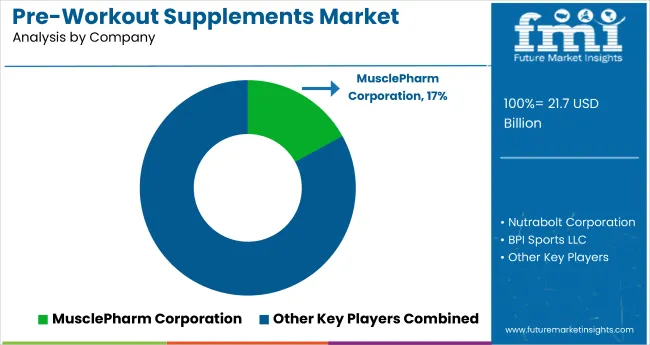
The pre-workout supplements market is moderately fragmented, with a mix of global players and niche fitness-focused brands competing across developed and emerging regions. Leading companies such as Muscle Pharm Corporation, Nutrabolt Corporation, BPI Sports LLC, Magnum Nutraceuticals, and GAT Sport are focusing on expanding their portfolios with clean-label, stimulant-free, and vegan formulations to cater to shifting consumer preferences.
Top players are adopting strategies such as competitive pricing, athlete and gym partnerships, and aggressive e-commerce expansion. Product innovation remains a core focus, with new ingredient formulations targeting energy, endurance, and recovery. Several brands are also enhancing their DTC (Direct-to-Consumer) reach by investing in personalized nutrition platforms and subscription-based services. Meanwhile, international expansion, particularly into Asia Pacific and Europe, is being pursued through distribution collaborations and retail tie-ups.
Recent Pre-Workout Supplements Industry News
| Report Attributes | Details |
|---|---|
| Current Total Market Size (2025) | USD 21.7 billion |
| Projected Market Size (2035) | USD 44.7 billion |
| CAGR (2025 to 2035) | 7.5% |
| Base Year for Estimation | 2024 |
| Historical Period | 2020 to 2024 |
| Projections Period | 2025 to 2035 |
| Market Analysis Parameters | Revenue in USD billions/Kilotons |
| By Form | Powder, Ready to Drink, and Capsule/Tablets |
| By Sales Channel | Offline Sales Channel (Supermarkets/Hypermarkets, Departmental Stores, Convenience Stores, Others) and Online Sales Channel (Company Website, E-commerce Platform) |
| Regions Covered | North America, Latin America, Western Europe, Eastern Europe, Balkans & Baltic, Russia & Belarus, Central Asia, East Asia, South Asia & Pacific, Middle East & Africa |
| Countries Covered | United States, Canada, United Kingdom, Germany, France, China, Japan, South Korea, Brazil, Australia and 40+ countries |
| Key Players | MusclePharm Corporation, Nutrabolt Corporation, BPI Sports LLC, Magnum Nutraceuticals, GAT Sport, Nutrex Research Inc., Beas t Sports Nutrition, SynTech Nutrition (Medix Laboratories NV), EFX Sports, and ALLMAX Nutrition Inc. |
| Additional Attributes | Dollar sales by product type, share by functionality, regional demand growth, regulatory influence, clean- label trends, competitive benchmarking |
The global pre-workout supplements market is estimated to be valued at USD 21.7 billion in 2025.
The market size for the pre-workout supplements market is projected to reach USD 44.7 billion by 2035.
The pre-workout supplements market is expected to grow at a 7.5% CAGR between 2025 and 2035.
The key product types in pre-workout supplements market are powder, ready-to-drink and capsule/tablets.
In terms of sales channel, offline sales channel segment to command 46.3% share in the pre-workout supplements market in 2025.






Our Research Products

The "Full Research Suite" delivers actionable market intel, deep dives on markets or technologies, so clients act faster, cut risk, and unlock growth.

The Leaderboard benchmarks and ranks top vendors, classifying them as Established Leaders, Leading Challengers, or Disruptors & Challengers.

Locates where complements amplify value and substitutes erode it, forecasting net impact by horizon

We deliver granular, decision-grade intel: market sizing, 5-year forecasts, pricing, adoption, usage, revenue, and operational KPIs—plus competitor tracking, regulation, and value chains—across 60 countries broadly.

Spot the shifts before they hit your P&L. We track inflection points, adoption curves, pricing moves, and ecosystem plays to show where demand is heading, why it is changing, and what to do next across high-growth markets and disruptive tech

Real-time reads of user behavior. We track shifting priorities, perceptions of today’s and next-gen services, and provider experience, then pace how fast tech moves from trial to adoption, blending buyer, consumer, and channel inputs with social signals (#WhySwitch, #UX).

Partner with our analyst team to build a custom report designed around your business priorities. From analysing market trends to assessing competitors or crafting bespoke datasets, we tailor insights to your needs.
Supplier Intelligence
Discovery & Profiling
Capacity & Footprint
Performance & Risk
Compliance & Governance
Commercial Readiness
Who Supplies Whom
Scorecards & Shortlists
Playbooks & Docs
Category Intelligence
Definition & Scope
Demand & Use Cases
Cost Drivers
Market Structure
Supply Chain Map
Trade & Policy
Operating Norms
Deliverables
Buyer Intelligence
Account Basics
Spend & Scope
Procurement Model
Vendor Requirements
Terms & Policies
Entry Strategy
Pain Points & Triggers
Outputs
Pricing Analysis
Benchmarks
Trends
Should-Cost
Indexation
Landed Cost
Commercial Terms
Deliverables
Brand Analysis
Positioning & Value Prop
Share & Presence
Customer Evidence
Go-to-Market
Digital & Reputation
Compliance & Trust
KPIs & Gaps
Outputs
Full Research Suite comprises of:
Market outlook & trends analysis
Interviews & case studies
Strategic recommendations
Vendor profiles & capabilities analysis
5-year forecasts
8 regions and 60+ country-level data splits
Market segment data splits
12 months of continuous data updates
DELIVERED AS:
PDF EXCEL ONLINE
Supplements And Nutrition Packaging Market
ACF Supplements Market Size and Share Forecast Outlook 2025 to 2035
PDRN Supplements Market Size and Share Forecast Outlook 2025 to 2035
Feed Supplements Market Analysis - Size, Share & Forecast 2025 to 2035
Gummy Supplements Market Size and Share Forecast Outlook 2025 to 2035
Fiber Supplements Market Size and Share Forecast Outlook 2025 to 2035
Vegan Supplements Market Analysis by Ingredient Type, Form, Customer Orientation , Sales Channel and Health Concer Through 2035
Andro Supplements Market
Beauty Supplements Packaging Market Size and Share Forecast Outlook 2025 to 2035
Urology Supplements Market Size and Share Forecast Outlook 2025 to 2035
Peptide Supplements Market Analysis - Size, Share, and Forecast Outlook 2025 to 2035
Calcium Supplement Market Analysis - Size, Share & Forecast 2025 to 2035
Calorie Supplements Market Analysis by Form, Packaging, Flavor, Sales Channel and Region Through 2025 to 2035
Dietary Supplements Packaging Market Analysis – Trends & Forecast 2025-2035
D-Mannose Supplements Market Size and Share Forecast Outlook 2025 to 2035
Carnitine Supplements Market Size and Share Forecast Outlook 2025 to 2035
Krill Oil Supplements Market Size and Share Forecast Outlook 2025 to 2035
Melatonin Supplements Market Size and Share Forecast Outlook 2025 to 2035
Green Tea Supplements Market Analysis - Size, Share, and Forecast 2025 to 2035
Probiotic Supplements Market Analysis - Size, Share, and Forecast 2025 to 2035

Thank you!
You will receive an email from our Business Development Manager. Please be sure to check your SPAM/JUNK folder too.
Chat With
MaRIA